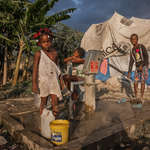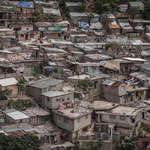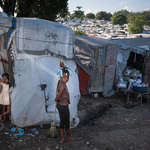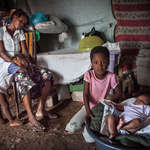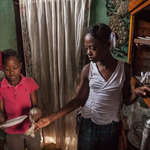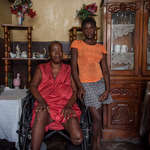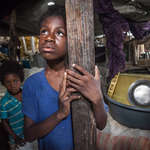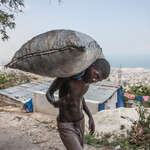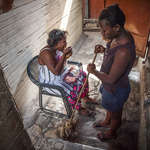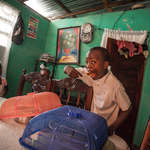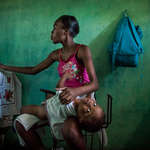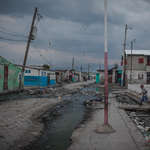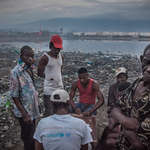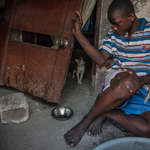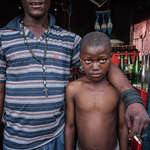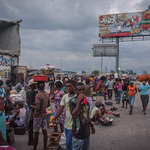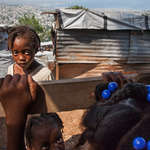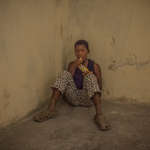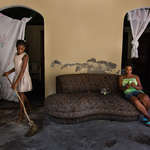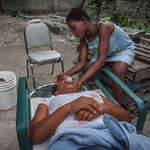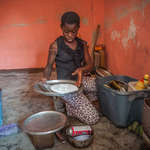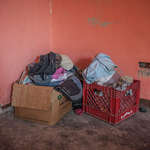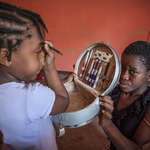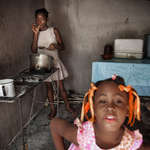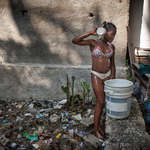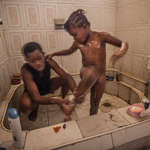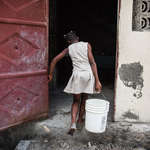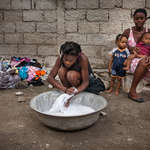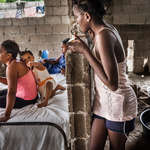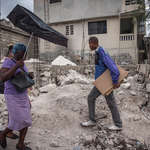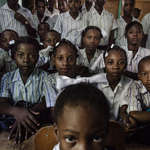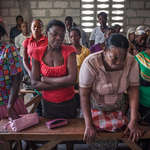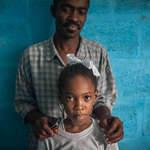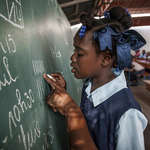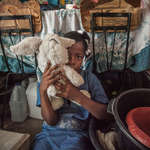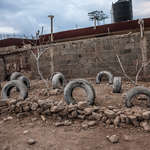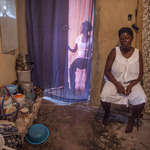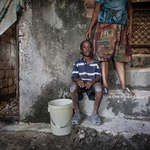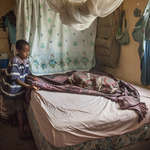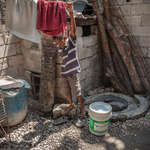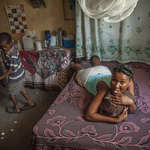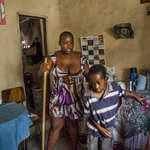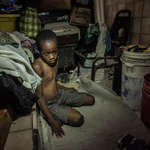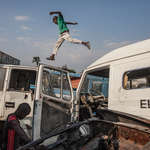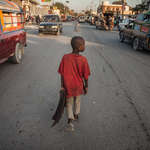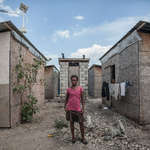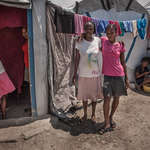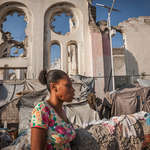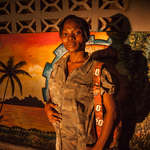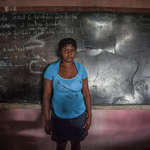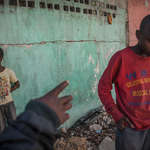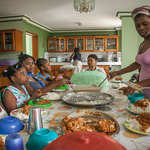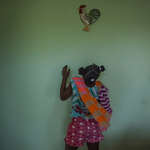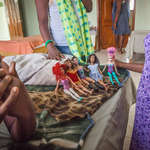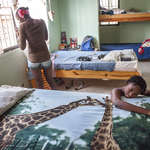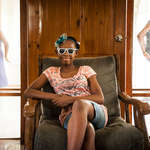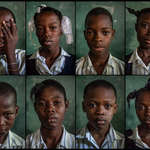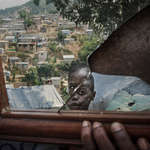
-
In modern Haiti more than 300,000 children are victims of domestic slavery. In Haitian Creole these children are called “restaveks”, a term derived from “reste avec” (French) which means “stay with”. Many parents who live in poverty are unable to feed their children. They give them away to more affluent families, hoping that their child will live in better conditions and will be able to get an education. But, with few exceptions, restavek children become slaves, working in the homes of their owners from early morning until night. They fetch dozens of litres of water each day, cook, wash clothes, clean yards and do all other household chores. They are not allowed to sleep on a bed, eat at the table with the rest of the host-family or play with other children. Most of the restaveks are not permitted to go to school and are constantly exposed to domestic and sexual violence.
After the 2010 earthquake, the situation in Haiti deteriorated significantly, as a lot of children lost their homes and parents. A large number of those kids became restaveks. Now, even poor families keep two or three restaveks, and are tougher on them than rich families.
-
There are several NGOs that aim to put child servitude in Haiti to an end. The Restavek Freedom Foundation finds families that have restavek children and convince them to allow the children to attend school, offering to pay for the education, school uniforms and books.
But it seems the help of NGOs is not sufficient to stop child slavery. Haitians, who emerged from centuries of slavery, do not hesitate to hand over their children as slaves. In rich families it is not uncommon for a bride to receive a child-slave as a wedding gift. Neither the government nor the church, which has a great influence in the country, is in a hurry to condemn the vicious practice of child slavery. Today Haiti remains one of the few countries in the world, where slavery still exists and continues to grow.
Kids fetch water from the public water pump in the tent camp of Pois Congo slum in Port-au-Prince. Child labour is very common in Haiti and many children start working from a young age
A slum in Port-au-Prince that was hit by the 2010 earthquake. Approximately one million people lost their homes. Many children became homeless or were given away by their parents as domestic slaves
Children at the refugee camp in Petion-Ville
Amberline (7, right) with her three-month-old brother, Loubes. Their mother Adeline (32, left) cannot afford to feed her three children or pay for Amberline’s schooling. Adeline says that in a few months she will give Amberline to a family as a restavek
Viviane (11, left) helping her sister, Islande (13) do the dishes in their host family’s house. The sisters have lived in servitude since 2008, when their mother gave them away
Jeanse (16) near her master, Jean-Felix Lousienne (44), who took her from the Pétion-Ville refugee camp. Jeanse sleeps and eats on the floor and is constantly exposed to beatings and verbal abuse. She does not have any identification documents and is not allowed to go to school
Francoise-Jessica (11) and her brother, Francois-Samuel (7), in their master’s house. Their mother gave them away as slaves after the 2010 earthquake, and since then they have been serving a poor family of four in the slum area of Morne L’Hopital, Port-au-Prince
A Haitian man carries a coal bag in Morne L’Hopital slum, Port-au-Prince
Bellefleur (16) has spent the past three years working as a restavek, doing all the household work for her masters
Olrtega (13) grabbing a bite to eat while his hosts are out. He was given away by his mother in 2008 and is not allowed to eat with the family
Starlie (14) changing the diaper of the son of her owners. Starlie, who became a restavek at the age of 10, is allowed to go to school, as the Restavek Freedom Foundation pays her school fees. After school, she has to do all the housework
A street in Cite Soleil, a slum in Port-au-Prince. According to the United Nations Stabilization Mission in Haiti (MINUSTAH), Cite Soleil is one of the poorest and most dangerous places in the country. Even here some households have slave children
People play dominos at the dump, Cite Soleil, Port-au-Prince
Faustin (16) works for a family in the slum of Cite Soleil. After Faustin’s mother died, his drug-addicted father sold him for a dose of heroin. Members of the host family beat him severely every day and deprive him of both food and education. In the evening, after finishing his chores, he goes to the shore to catch fish that he eats and trades for clothes
Etienne (11) lives with Ivene (32), a grocery and liquor-store owner in Cite Soleil, a slum in Port-au-Prince. Etienne works long hours in the shop and, like many restaveks, is subjected to abuse
People on the street of Port-au-Prince
Givnin (7, top left) plays with her friends in Tapis Rouge slum, Port-au-Prince. She will spend only a few months more with family and friends. Givnin’s mother decided to give her daughter away to a host-family, because they live in extreme poverty and she cannot provide enough food for all her children
Judeline (12) in her room. Since 2009 she lives with the family of an English teacher who is also a fixer. She is allowed to go to school, but does most of the household chores
Judeline (12) cleaning the floor while her host checks the messages on her cellphone
Judeline (12) washing her mistress’s hair
Judeline washes dishes after the family lunch
Two boxes of personal items are Judeline’s only belongings. She works for the host family in exchange for food, going to school and a place to sleep
Teacher's daughter Boubou (6) applies make-up while Judeline (12), holds a make-up kit for her
Judeline (12) cooking food while the host family’s daughter, Boubou (6), plays
Judeline (12) washes in a bucket in the yard behind the house. She is not allowed to use the bathroom inside
Judeline (12) bathing Boubou (6). Judeline is not allowed to use the bathroom, so only goes there to wash Boubou or fetch water
Judeline (12) brings water from the well. She goes to school, but can only do her homework once she has finished all of the household chores. She is not allowed at the table and so sits on the step to study
Edeline (14), who became a restavek after her parents died in 2004, washing clothes for a family of 13, while Jules, one of her bosses, sits by with her children
Marie-Ange (14), an orphan and restavek in a middle-class family home, watching her owners talk to visitors. As a domestic slave, she cannot remain in the same room as guests, but must always be available
People on the street of Port-au-Prince. In 2013 the Haitian capital was still recovering after the 2010 earthquake, which left many houses in ruins
Children in a primary school classroom in one of the neighbourhoods of Port-au-Prince. All of these children are restaveks and receive free education provided by the Restavek Freedom Foundation. They still live with their host families and every day after school they go back to their chores. Most of the kids are not allowed to play with other children and school is the only place for them to interact with their friends
Modern slaveholders praying before a meeting with child advocates from the Restavek Freedom Foundation (RFF), at a school in Port-au-Prince. The NGO has conducted a series of workshops for host families to help change attitudes towards restaveks
John (40) with his restavek girl Mamaika (8), who has been serving for him since the 2010 earthquake
A restavek child (12) learning to count at Kwadbouke School, Port-au-Prince. The Institute for Human and Community Development provides free education and physical and mental healthcare for child victims of slavery
Mamose (12) with her sole toy, a bunny, while her master is out
A children's playground at the one of the neighbourhoods of Port-au-Prince
Florila (47) and her restavek girl Beltine (18). Beltine has been living with her master since 2010. Recently she has become pregnant to a man who denies being the father of the unborn child. Beletine had to leave school. She is scared she will be expelled from the house when her master finds out about her pregnancy
Enso (10) was found by his host family on the street when he was one-year old. He began working for them at the age of two, and now does all the chores for the household of six. Port-au-Prince
Enso (10) makes his master’s bed
Enso (10) near the well. He has to bring dozens of litres of water every day to meet his master’s needs
One of Enso’s bosses relaxes while Enso (10), a domestic slave, sweeps the bedroom floor
A member of the host family scolding Enso (10) for work he has not done properly
Enso (10) has no bed or pillow and sleeps on rags on the storage-room floor
Children playing on cars in a junkyard in Port-au-Prince
Lilyo (10), an orphan and former restavek, escaped from his host family in 2011. He sleeps in abandoned buildings with other street kids and makes his living by washing cars, preferring a dangerous, but free, life to servitude
Roselande (16) near her uncle’s house in Village du Bien settlement of Port-au-Prince. She ran away from her host family and took shelter here, where her uncle lives with another seven family members
Claudette (19) with her mother Sadila (61) in front of their tent in one of the refugee camps of Port-au-Prince. Sadila gave her daughter to slavery in 2009. After the earthquake her master's wife moved to the US and left Claudette to live with her husband and son. After they made several attempts to sexually abuse Claudette she begged her mother to accept her back. Now she lives with her mother and sister and goes to school
Nadine (22), a former restavek, in front of the ruins of the Port-au-Prince Cathedral, which was destroyed by the 2010 earthquake. Nadine was mistreated by her host family and then transferred to the Restavek Freedom Foundation Transitional Home. She is now doing a professional dressmaking course and hopes to find to a good job
Muriell (21) was given away to a host family when she was 13. Until the age of 20 she served people who mistreated her almost every day. At the end of 2012 she was raped by her master and became pregnant. She was expelled from the house after the family found out about the pregnancy and now works in acquaintances’ houses in order to survive
Jeanpoux (28), became a restavek in 2000 and served a woman who did not allow her to go to school. In 2010 Jeanpoux was taken from slavery by a local protestant pastor and went to school for the first time in her life. Now she attends classes of the Literacy Program for adults at the Pois Congo area of Port-au-Prince
Peterson (12, right) ran away from his master after "gudu-gudu" (Creole name for the earthquake), because she was beating him almost every day. He lives on the street with a former restavek, Wesly (12, left), and two other orphans. They sleep in remains of destroyed buildings in downtown Port-au-Prince and make their living as street beggars
Lunch in the Transitional Home, built by the Restavek Freedom Foundation as a shelter for restavek girls abused by their host families. Residents of this secure environment attend one of the best schools in Port-au-Prince
Girls play in the Transitional Home
Former restaveks, who were abused by their host families, playing in their bedroom in the Restavek Freedom Foundation's Transition Home, Port-au-Prince. The home can accommodate 12 girls
Leonise (18, left) and Rose (15, right) in their room at the Transitional Home, Port-au-Prince
Victoria’s father gave her to a host family as a restavek after the 2010 earthquake. The host family subjected her to abuse and beatings until the Restavek Freedom Foundation removed her from slavery and placed her in the Transitional Home. Victoria (15) dreams of obtaining a university degree and becoming a bank accountant
Portraits of restavek children in one of the schools in Port-au-Prince. All of these kids have their school fees paid by the Restavek Freedom Foundation. After school they go back to their daily chores at the houses of host families, where many are constantly exposed to domestic violence
A boy reflected in a hairdresser’s mirror in the Tapis Rouge slum area of Carrefour Feuilles neighbourhood, Port-au-Prince. Despite the work of many international organisations, many Haitians still accept the restavek system and about 300,000 children live in domestic servitude
